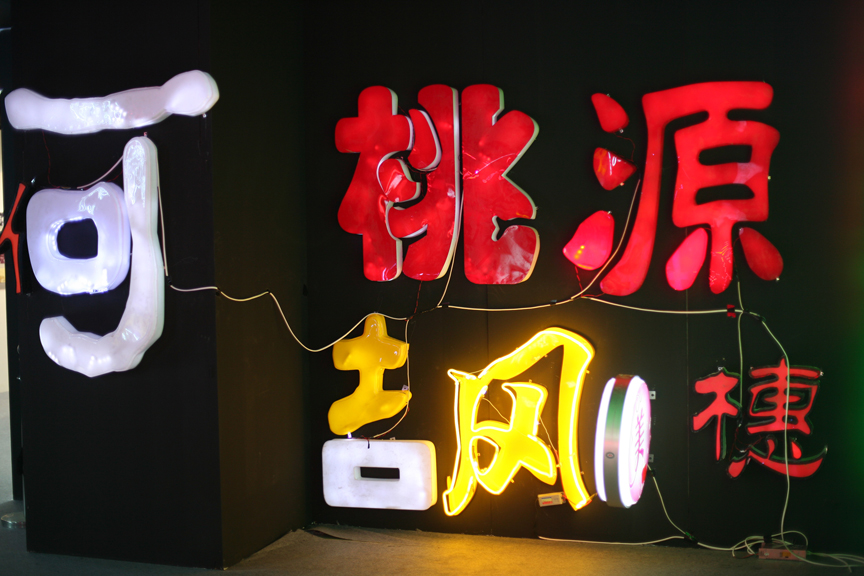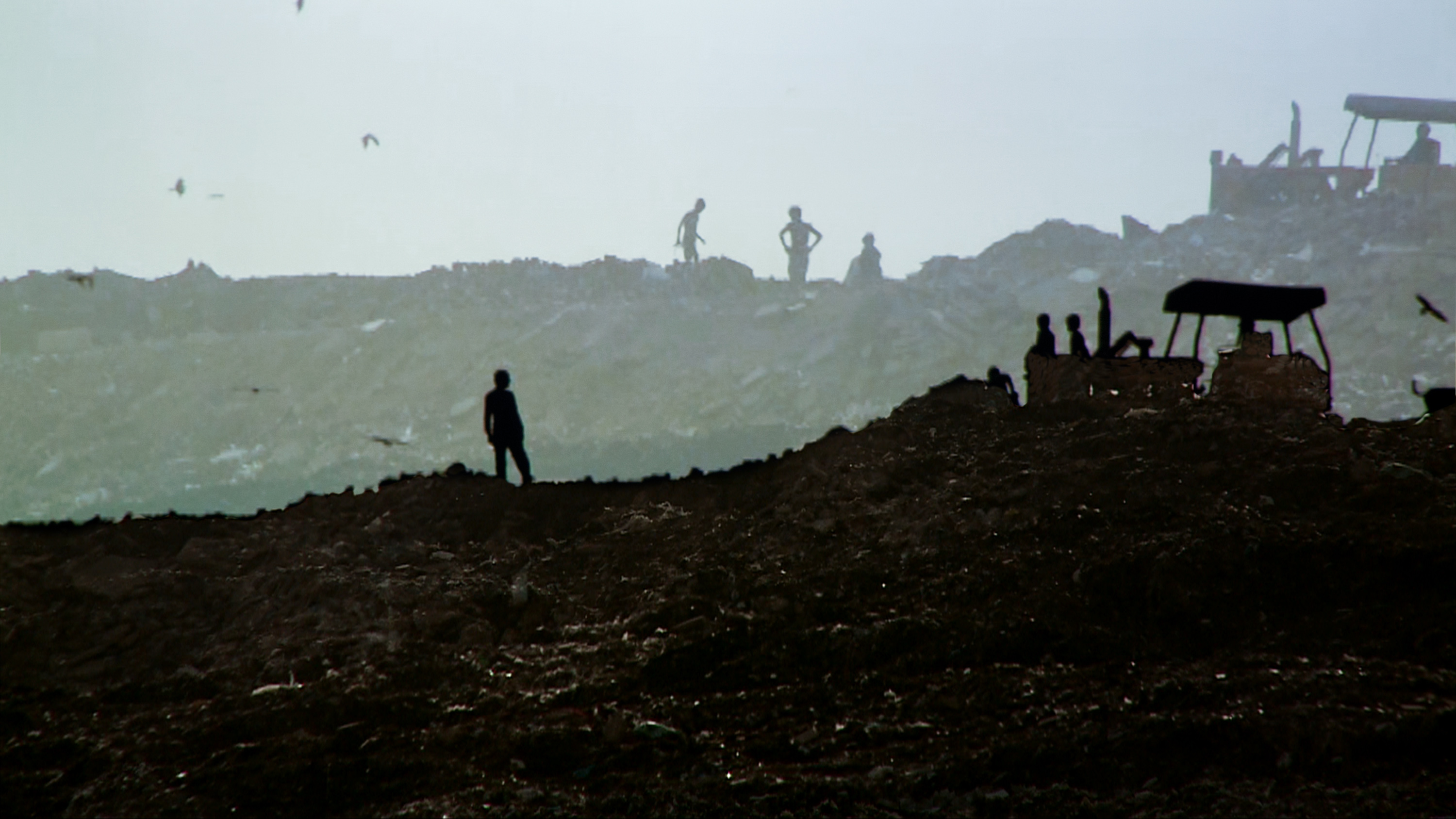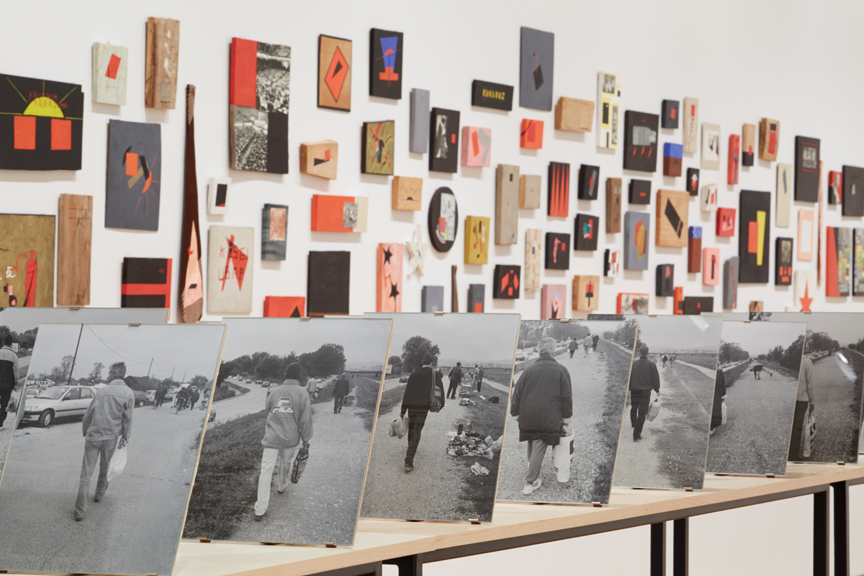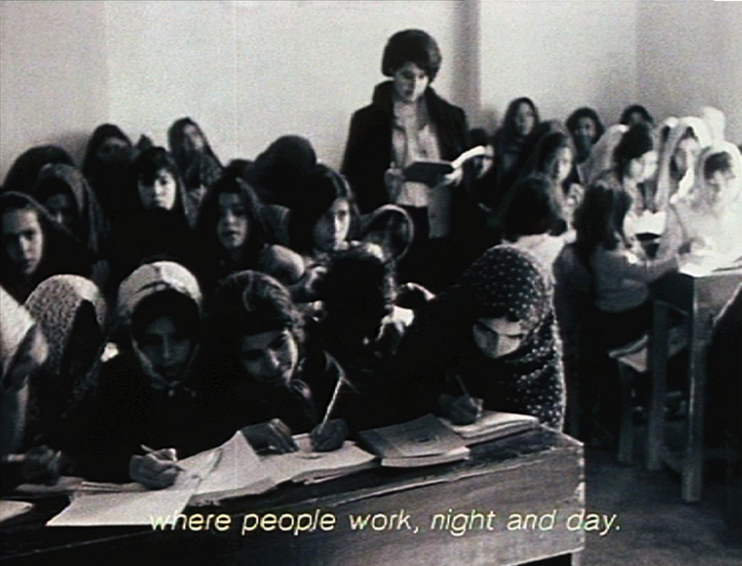Shows
Carnegie International 2013


Beneath a chorus of angelic figures in John White Alexander’s towering 1907–08 mural The Crowning of Labor, a paean to scientific knowledge and human progress that fills the Grand Staircase of the Carnegie Museum of Art, and behind a vitrine of ghoulish drawings by Rokni Haerizadeh—in which he overlays animalistic creatures and demons onto news photographs of political events such as protests in Iran or the British royal wedding—there is a small water fountain embedded in the wall. In such a resplendent setting, this modest public feature appears oddly sensible, hospitable, civic-minded, if slightly anachronistic—all attributes that equally could describe the 2013 Carnegie International.
Comprising projects by 35 artists from 19 countries, the 2013 Carnegie International is an exhibition very much made for Pittsburgh and for the Carnegie Museum of Art itself. The three curators—Daniel Baumann, Dan Byers and Tina Kukielski—spent several years searching out artists whose works would resonate in the still-beleaguered former steel capital and with the specific collection of the museum, which contains many works debuted in past Internationals, from the midcentury likes of Georgia O’Keefe and Alberto Giacometti to contemporaries like Huang Yong Ping and Haegue Yang.
The exhibition-making process may have been slow, but time has its rewards. It is a show that neither exhausts you nor itself, with a depth that derives from the generosity and seriousness of the selected artists’ projects, rather than curatorial expansiveness or encyclopedic aspirations. To that end, the show has no title, nor an overarching curatorial theme. (“One important decision we made very early on was to build the exhibition around the artists,” Baumann writes in the catalog.) Yet there are no loose threads here. Collectively, the artworks express a rooted humanism, in forms ranging from community-oriented projects, documentary films to figurative paintings and abstract sculptures—with several artists receiving generous attention in miniature retrospective surveys.


Of the projects specific to local communities, there was a strong focus on addressing the problems of postindustrial Pittsburgh (and similarly blighted urban contexts), such as unemployment, street violence and pollution. One of the exhibition’s centerpieces is Magnum photographer Zoe Strauss’s Homesteading project (2013), in which she took portraits of United Steelworkers union members and other residents of nearby Homestead (once home to Andrew Carnegie’s largest steel mill) during her stint at a pop-up photography studio in the months before the International’s opening. Near the ticket desk, the collective Transformazium, based in nearby North Braddock, set up an Art Lending Collection, so visitors could browse artworks available to loan for a couple of weeks—like a library book. Even when sourced from overseas, selected projects resonated in the local context. In the neoclassical Hall of Sculpture was Pedro Reyes’s Disarm (2012), automated musical instruments assembled from handguns that had been confiscated in Juarez, Mexico, where drug-related violence has terrorized communities. Two of Amar Kanwar’s elegiac films (The Scene of Crime, 2011, and A Love Story, 2010) find oddly beautiful scenes amid large-scale environmental devastation in the Indian state of Odisha. The pair of sculptures by He An, What Makes Me Understand What I Know? (2013), cobbled together from disused commercial light-box signage—the artist collects the three Chinese characters that spell out the names of his father and four characters for the name of a Japanese pornstar—speak about the search for some kind of redemptive meaning, however idiosyncratic and sentimental, in an alienating urban landscape.



Along with this attention to community-oriented projects was the curators’ interest in the depiction of the human form. In her “NUD” (2009) sculptures, Sarah Lucas stuffs cotton into stockings that she then contorts into tumescent forms and places atop concrete-block pedestals. Surrounding Lucas’s sculptures were the large-scale figurative paintings by Henry Taylor, of his Los Angeles neighbors, as well as iconic African-Americans such the Black Panther leader Eldridge Cleaver reclining in a chair, which collectively portray racial segregation in the United States. In a nearby room were Guo Fengyi’s delicate colored-ink drawings based on the medicinal practice of Qigong, which are unfurled down the walls like vertical scrolls and depict energies coursing through the bodies of figures like Tang Dynasty princess Wencheng and the Statue of Liberty. Around the balustrade of the Hall of Sculpture—lined with examples of classical Greek and Roman sculpture—is a large selection of Nicole Eisenman’s darkly satirical paintings made from the 1990s to the present, depicting grotesque scenarios with undercurrents of incipient violence. They are joined by several examples of her ungainly larger-than-life plaster figures—oafish, plebeian rejoinders to the idealized classical bodies that surround them.
As with Eisenmen’s works, curators give an overview of the career of the Croatian avant-gardist Mladen Stilinović. There are examples of Stilinović’s pioneering practice dating back to the 1970s in Zagreb with the Group of Six Artists, and his solo projects such as his manifesto In Praise of Laziness (1993) (his conclusion: “there is no art without laziness”), and his banner An Artist That Cannot Speak English is No Artist (1992). Even in its most recondite moments, the International never strays far from the collection that surrounds it. Curators deftly installed Dictionary–Pain (2000–03), in which Stilinović painted over the definitions in 523 pages of an English-language dictionary and replaced them simply with the handwritten word “pain,” in such a way that, looking at room-filling piece, the viewer can also see into an adjacent gallery of medieval and early Renaissance art, full of pietas, crucifixions—scenes of suffering from a half-millennium earlier.


There’s plenty of straightforward fun, too, in the Carnegie International. In fact, there’s a whole section about the history of playgrounds, with models and photographs about famous examples from Europe, the United States and Japan, guest curated by Gabriela Burkhalter. A remarkable number of historical, social and aesthetic currents were embodied in these aspirations and designs—from back in the days when urban planners actually considered the public as social, creative entities rather than merely worker-consumers. Within the Playground Project, Tezuka Architects has designed a balloon filled, bubble-wrap-floored space where they have projected images of their radically designed, no-walled kindergarten in Fuji, Japan. Meanwhile, Ei Arakawa and Henning Bohl made a zany, rambling sci-fi road movie with Ei’s mother and Bohl’s daughter about exploring Japan to look at famous playgrounds and schools designed by Mitsuru Senda. And why not? In another setting, it might have seemed indulgent and tedious, but here at the Carnegie International it was all of a piece, as the curators were slyly suggesting that the art exhibition at large could be reconceived as an area for play. That idea, once it sunk in, helped to explain how an experience like seeing the Carnegie International could be both challenging and so enjoyable at the same time. It also explained why, outside the museum, there is a snaking multicolored plastic tube with portholes, known as a Lozziwurm (originally designed in 1972 by Swiss artist Yvan Pestalozzi).
Thinking about the museum as a playground put the prevalent idea of formal experimentation within the show in an entirely different light, one connected to Stilinović’s anti-capitalist work ethic and the humanizing, de-idealizing depictions of the body in the works of Eisenmen, Taylor and Lucas. Pushing formal experimentation (or “play”) into further abstraction was a selection of Vincent Fecteau’s contorted papier-mâché sculptures, Sadie Benning’s tableau of bold graphic panels made in painted wood, and a room of Erika Verzutti’s hermetic, rock-like sculptural objects—each of which, in their own distinctive manner, had something intriguingly strange or unresolved about their appearance, an awkwardness taken to the point of being interesting. With works like these, curators reminded viewers that art-making, like play, can be done for its own sake and does not have to always be “critical” (furrowed brow) or spectacular (wide eyes) to be worthy of attention.



While these projects were very much in keeping with the International’s long history of introducing avant-gardism to the public in the United States, two presentations took up the idea of the International’s distinctly American audience in an interesting way. Dinh Q. Lê’s project Light and Belief: Sketches of Life from the Vietnam War (2012) comprises one hundred drawings and paintings created by artist-soldiers from North Vietnam, who documented the American-Vietnamese War in their works, as well as a partially animated documentary with several of the still-living artists. Though commissioned by and debuted at Documenta 13, in Kassel, Germany, in 2012, the series has far greater significance for an audience in the United States that was more likely to include military veterans and their families, as well as anti-war protesters.
The other striking, unique presentation from a country with a tangled history with the United States, came from filmmaker Kamran Shirdel, whose cinema verité-style documentaries captured life in the 1960s-era Iran. Several of these had been officially commissioned and then subsequently banned in the 1960s by the Ministry of Culture and Art, and they were only completed when Shirdel retrieved the footage after the 1979 Islamic Revolution Among the six films screened in the museum’s commodious theater was The Night it Rained (1967–74), about a village boy who reportedly had prevented a train crash. When Shirdel arrived on the scene, however, he found that everyone involved, from station-masters to track engineers and local officials, gave a different account of the events, largely disparaging the boy in order to protect themselves. Shirdel’s films repeatedly undermines the sanctioned narratives that mask official perfidy—an universal condition if there ever was one.
It sounds almost preposterous to praise a large-scale exhibition for showing consideration to viewers, a thoughtfulness about its context and a deep respect for artists’ practices. But in these days of countless hastily thrown together, sprawling biennials—too big to be seen in even two or three days—and yoked together under some tediously vague theme, the 2013 Carnegie International is an exceptional mega-exhibition, which is what also gives it a modest, anachronistic feel. The avaricious trendiness that characterizes most biennials puts their curators and organizers, often inadvertently, in thrall to fleeting art-market trends and hackneyed intellectual fads. (These days, if that’s what you crave, that’s exactly what a sophisticated, calculating art fair can be good for.) Staying close to the artists’ own works, while being rooted in Pittsburgh’s cultural life and within the collection of the Carnegie Museum of Art protected the International from the most cynical aspects of the art world’s egoistic spinning. Like that small drinking fountain in the Grand Staircase, the 2013 Carnegie International provides its audience with honest, refreshing sustenance.
The 2013 Carnegie International runs through March 16, 2014.
HG Masters is editor-at-large at ArtAsiaPacific.







